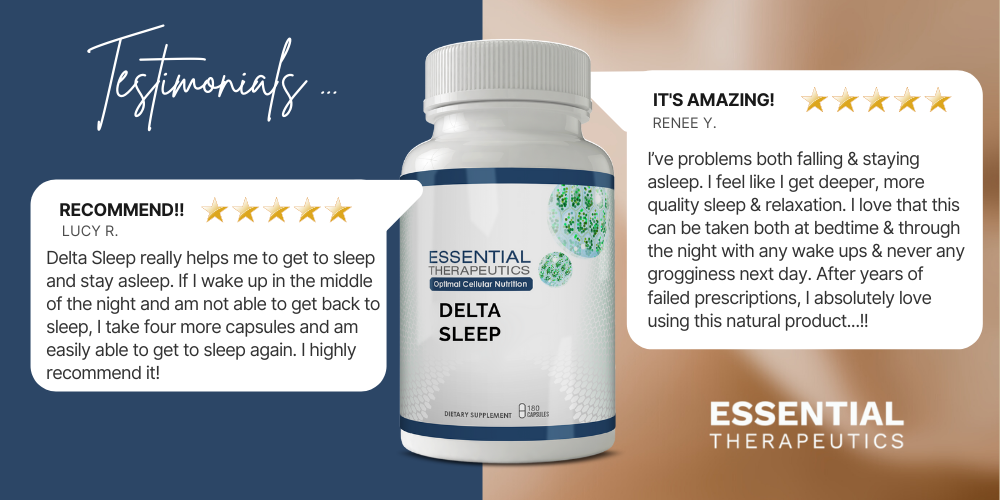5 Ways to Heal From Within
updated August 2020

Making time each and every day to calm your mind and tap into a higher consciousness pays huge health dividends. In times of high stress, like today, it’s important that we focus on our mental health, and it plays such a huge role in our overall physical health. Knowing what areas of your daily life are triggers for you, will help to know what brain chemicals you may be low in.
Being in practice for almost 3 decades, I have found that many of you fit into certain groups depending on how you answer the questions on my Brain Function Questionnaire. Please use this questionnaire to find the group you fit into. It will help guide you on your road to wellbeing and recovery. Let’s see which brain chemicals (neurotransmitters) you may be low in by taking this quiz, here.
Based on questionnaire results, one of the more common recommended supplements is our Essential Therapeutics Gaba Plus. You can learn more about it in the video below:
The Healer Within: Focus Inward – Enjoy Optimal Health
We are born with an innate ability to heal ourselves. If this were not true, we would quickly succumb to the millions of deadly microbes that inhabit our lungs and digestive tracts. These bugs are monitored and kept in check by the inner healer, the autonomic nervous system. It also controls how fast your heart beats, the rate of your breathing, how you walk, how you stand, and how fast blood pumps through your veins. It coordinates all functions of the body, including the immune system. Do you have to think about healing a broken bone? No. Your inner self maintains a constant vigil, overseeing every bodily process. We are truly amazing organisms.
You have a new liver every six weeks, and 98 percent of the atoms in our bodies are renewed every year. The power that made the body is ultimately the power that heals it. Understanding this concept can be intimidating. Medicine has been blinded by science and has largely neglected the profound influence of our higher self. Health professions are known as the “healing arts,” yet the art of medicine has been too often replaced with brain scans and drug therapies. But true health is more than the absence of disease. It is optimal physical, chemical, and spiritual well-being.
Mind Chatter and Responsive Thoughts
Our minds never stop chattering. We—consciously or subconsciously—take in, sort, analyze, and respond to billions of thoughts each day. This constant chatter, if not checked, begins to take its toll on our mental and physical well-being. Negative thoughts can create a blueprint for the subconscious mind to rely on. A few negative thoughts a day aren’t so bad, but thirty years of incessant worry shapes who we become as people, our personality. Your script is being written and rewritten every day by every thought you have.

I could write at length about all the mind-body studies and how they relate to emotional, mental, spiritual, physical, and chemical health, but I think it’s really this simple. Do you feel better or worse when you are laughing? How about scowling? It doesn’t take a scientific study of brain scans and heart monitors to know the answers.
Did know you can’t stay sad or angry when smiling at yourself in the mirror? This is because the muscles in the face, when contracted into a smile, trigger the brain to release happy hormones. I’ve found I feel and look my best when I’m physically and mentally rested.
When I make the time to tone down the mind chatter and begin to listen to my inner voice, the rewards of my efforts are health, vitality, and joy. I’m not implying that you can think, meditate, or even pray yourself free of ailments of life’s most difficult challenges. However, finding and tapping into your inner self only increases your chances of getting and being well in its truest sense.
We can’t always control life’s obstacles, but we can control how we respond to them. Your state of health is largely determined by how well you recognize this concept and your willingness to listen and trust your inner self.
1.The Healing Power of Prayer
Although 95 percent of Americans believe in God, most doctors are uncomfortable discussing spiritual topics. This is disappointing for many; 60 percent of the population would like to discuss spiritual matters with their doctors, and 40 percent would like for their doctors to pray with them.
The effects of prayer are numerous: lessened anxiety, stress, and anger; lowered resting pulse rate and blood pressure; increased production of happy hormones; and increased pain threshold. In addition, prayer and other spiritual practices tap into the mind-body connection. They have a calming effect that involves every system in the body, including the nervous system, immune system, endocrine (hormonal) system, digestive system, and cardiovascular system. One study involving individuals with HIV showed that participation in religious or spiritual activities substantially improved immune function.
One of the most talked-about studies evaluating the positive benefi ts of prayer was published in The Southern Medical Journal in 1988. It involved 393 hospitalized patients who were equally divided into two groups: one group served as the control and was treated with traditional medical care alone. The second group received prayer along with traditional medical care. Neither group, nor their doctors, knew who was receiving prayer from third parties. The group receiving prayer had these remarkable results: they had fewer congestive heart failures (eight versus twenty), fewer of them needed diuretics (five v. fifteen), they experienced fewer cardiac arrests (three v. fourteen), they had fewer episodes of pneumonia (three v. thirteen), fewer of them were prescribed antibiotics (three v. seventeen), and they generally required less medication than the control group, who received no prayer from the volunteer third parties.
2. Tapping into Your Inner Self
One of the healthiest things you can do in this lifetime is to learn to rise above the constant mind chatter by quieting your mind and allowing your inner self to flourish. You’ll start to realize how negative and self-destructive thoughts sabotage your innate desire to be healthy. Life’s true game is less about controlling your surroundings and more about letting go of unwanted negative thoughts—much like shedding layers of clothes when entering a warm room. The ability to control our minds by understanding, acknowledging, and choosing which thoughts, emotions, and feelings serve us best is perhaps the key that unlocks optimal health. Below are just a few ways to quiet the mind and tap into your inner self.
3. Conscious Breathing
Conscious breathing is one way to integrate your mind and body. Focusing on breathing, using mantras (repetitive sounds), and/or visualizing a word or a soothing scene are central to most meditative practices. In basic breathing exercises, all you need is a quite place and a willingness to quiet the mind. Conscious breathing reduces stress and allows you to filter out the constant mind chatter. Quieting the mind offers the opportunity to get in touch with your inner self. A conscious breathing exercise can be done any time of day and as often as you wish. Use it as a powerful stress-busting tool when you are feeling overwhelmed:
Bring your attention to your breathing. Notice the flow of breath in and out of your lungs. Take a deep breath in through your nose, allowing the air to fill your lungs. Slowly exhale through your mouth. Observe the rhythm that naturally occurs. Acknowledge any distracting thoughts, and simply let them go when they appear. Return your attention to the rhythm of your breathing. Continue to take deep breathes in and out. When it feels natural, try allowing more time between each breath. Pause when appropriate, and feel the inner peace. Enjoy the freedom from mind chatter.
4.Refocusing
This technique helps you to take control of your mind. Too often we find ourselves at the mercy of our emotions and have knee-jerk reactions that don’t serve our higher self. When facing a stressful situation that threatens to overwhelm your best intentions, stop and take time to consider the wisdom of your inner self. This allows you to avoid being at the mercy of old negative habits and to write a new positive script that serves you better.
Stop. Call time out. Take several deep breaths. Remember that with the help of your inner self, you can take control of a situation.
Look. Rise above the situation and just be an observer. Notice how you feel, your thoughts, your surroundings, any other people involved. Be objective. Take it all in.
Listen. Take a few minutes to focus on your breathing. Listen to what your inner self is saying. Pay attention to your chest area. Notice how you feel. Is this how you want to feel? Listen deeply. What is your inner self, your inner voice, telling you about this situation?
Choose. Make an affirmative statement about what you wish to choose in light of this situation “I choose to feel calm, balanced, and open to positive experiences.”
Let it go. Choose happiness, peace, and serenity over having to be right. Choose acceptance of not knowing over having to understand. Choose love over hate. Choose thoughts of improving health over nagging reminders of disease.
5. Meditation
Meditation can generally be divided into two categories: concentration methods, which emphasize focusing on your breathing or a specific object, and mindfulness meditation, which usually uses chants, focused breathing, or repetitive thoughts. The goal in either case is to allow thoughts, feelings, and emotions to appear moment by moment without placing any attention on them. Simply let the thoughts enter. Acknowledge them and let them go, allowing yourself to tap into your inner self. Meditation may be especially helpful for chronic pain. Others studies have shown the effectiveness of meditation for anxiety, substance abuse, skin ailments, and depression.
Bringing it All Together: The Hour of Power
Taking time on a daily basis to quiet the mind is a crucial component of living the lives we want to live. I try to find an hour of power every morning. My hour of power involves prayer, meditation, and exercise. What could *your* hour of power include?
These patients and hundreds of others who’ve worked personally with me have in fact beaten their fibromyalgia. You can read or listen to their stories by clicking the link below:
|
|








Great post, Dr. Murphree.
“It doesn’t take a scientific study of brain scans and heart monitors to know the answers.” a very simple perspective and approach to understanding ourselves.
“Did know you can’t stay sad or angry when smiling at yourself in the mirror?” On this same note, I always hear how it’s difficult to be resentful and grateful at the same time. Through prayer, meditation, and self-love, we learn to be satisfied and happier with what we have today.